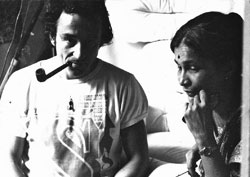The West's focus on India in film
When Vijaya Mulay got the idea for a book about filmmakers’ fascination with India, she didn’t think she would be the one to write it.
She certainly couldn’t have predicted that the publication of As Others See Us, a critical survey combined with personal memoirs, would coincide with her 85th birthday, nor that it would be the impetus of a film festival.
The film festival, which opens on May 5 and runs for two weeks in venues around Montreal, is called Phantom and Fact: India in Western Film and Video. It is sponsored by Concordia’s Mel Hoppenheim School of Cinema, the Cinémathèque québécoise, the Goethe Institute and a number of local South Asian community groups.
Cinema Professor Tom Waugh has been a self-described “India person” for 35 years. He met Mulay as he was preparing for his first film research trip there in 1988 under the asupices of the Shastri Indo-Canadian Institute. By then she was an established documentarist, involved in educational television and satellite broadcasting. She had even done a stint as a film censor.
Waugh programmed Phantom and Fact with Peter White, an independent curator, who mounted a series of exhibitions and events on Indian contemporary art and culture in Montreal in 2001. He is a member of CERAS, the South Asian Centre. White and Waugh both speak warmly of Akka (Mulay’s nickname, meaning elder sister).
Mulay’s book covers 100 years of Western cinema focused on India. “I am not aware of any scholarly work written about how a country has been viewed and treated in film,” White said.
Waugh agreed, saying that surveys usually address how different races or communities are treated in film “There has been nothing about the vision of a whole culture as seen through different cinematic lenses.”
Both men agree that Mulay’s approach is unorthodox. “It’s critical, but it’s not a postcolonial critique,” Waugh said.

Mulay and Louis Malle forged a friendship in the 1960s. The relationship got off to a rocky start when Malle learned she was a film censor.
Waugh and White worked with the collections of the participating institutions to present the range of material Mulay writes about. The full schedule is available at www.centrekabir.com
Gaps are inevitable, and Waugh regrets the lack of early newsreel footage. The festival does include early Orientalist depictions by German Express-ionist filmmaker Fritz Lang.
Mulay’s friendship with French New Wave director Louis Malle is acknowledged through a series he produced with the BBC in the 1960s for French TV. Waugh described that period as when “the hippie highway led to India.”
Waugh said film buffs will be impressed by the opening-night presentations. The Light of Asia is of interest to film historians, and India’s Struggle for National Shipping was thought to be lost.
Mulay will give the keynote address on her book on May 13, and participate in a panel the next day. She divides her time between Montreal (one of her three daughters lives here) and Delhi. She continues to collaborate with Waugh; she helped select films for the festival while he wrote the introduction to her book.
“We wanted to acknowledge the serious art film directors she knew, like Malle and James Ivory. But she told me to be sure to include some trash,” Waugh said with a laugh.
The festival, like her book, addresses both extremes.

